Smartphone Audio Testing - HTC One M8 and Samsung Galaxy S5
by Chris Heinonen on June 2, 2014 8:00 PM EST- Posted in
- Smartphones
- Mobile
- Testing
- Audio Precision
HTC One M8 Audio Testing
Looking at the numbers for the HTC One M8 there are a few things that stand out. The first is the output power of around 1.2 Vrms for all loads. This is a lot of power for a smartphone and should be able to drive almost any set of headphones you would use with it. There is more distortion on the 15 Ohm load but as there are 95 mW at max volume, you should be able to step the volume down a bit and reduce the THD+N.
We also see that crosstalk gets better as we have an easier load to drive. The lower (more negative) the crosstalk is, the less noise is leaking from one channel into the other. This is also the test most subject to error when using the USB automation of the phones. On the HTC One M8, USB testing results in a crosstalk level of -0.01 dB. If you are using your HTC One M8 for music you are best to not have it connected over USB while listening.
| 15 Ohm | 33 Ohm | 150 Ohm | 330 Ohm | |
| Dynamic Range | 91.791 dB | 92.074 dB | 91.690 dB | 92.008 dB |
| THD+N | 0.3365% | 0.0152% | 0.0103% | 0.0101% |
| Crosstalk (L) | -58.032 dB | -64.780 dB | -77.688 dB | -83.656 dB |
| Crosstalk (R) | -57.950 dB | -64.329 dB | -77.194 dB | -83.240 dB |
| Output Power | 95.55 mW | 47.63 mW | 11.14 mW | 5.116 mW |
| Output Voltage | 1.197 Vrms | 1.254 Vrms | 1.293 vRMS | 1.299 Vrms |
| Relative Level (20Hz - 20kHz) | ±0.664 dB | ±0.664 dB | ±0.665 dB | ±0.665 dB |
For some of the other results, I am going to pull in some charts that help to explain it better.
Relative level shows it is flat until the 20 kHz tone. Since most people can’t even hear this, the fall off there isn’t a large deal. The fall-off at 20Hz, which most earbuds cannot produce to a reasonable level, is much more slight and not audible. Unless you are playing back music for your puppy with the HTC One M8, this result is fine but it could be better.
THD+N is below 0.03% until just after 2 kHz when it begins a slow rise up past 0.2% at 20 kHz. This winds up being a good number but I am unsure what causes the rise in THD+N as the frequency increases.
The FFT spectrum for the 997 Hz test tone shows all artifacts below -80dB compared to the fundamental. The second and third harmonics are the largest, and those drop off by -10dB by the 4th and 5th.
This graph compares the frequency response to the BoomSound feature to having it disabled. As we saw earlier the regular frequency response is flat with a steep fall close to 20 kHz. Looking at BoomSound we see a steep roll-off below 30 Hz, a peak of almost +5dB around 60 Hz, a -5 dB section between 200 Hz and 500 Hz, and then a steep rise in the treble past 2 kHz.
Since I didn’t do the subjective listening, I would expect this to sound harsh in the treble, with the midrange being washed out by that dip in the middle. What we have is a high-end and a low-end that is +10 dB compared to the midrange. So these will sound twice as loud to you as the midrange. Using the interactive chart of music instruments by frequency you can find here, you can see what instruments this will obscure.
Comparing the THD+N ratio of BoomSound On to Off shows far more noise and distortion as well. If you want boomy bass, a harsh top-end, and no midrange, then use BoomSound. A better choice is to find headphones that suit your listening preferences more.
The HTC One M8 has good looking numbers, but putting them into better perspective requires more phone testing. As it is I see nothing that stands out as being a problem, unless you leave BoomSound on.


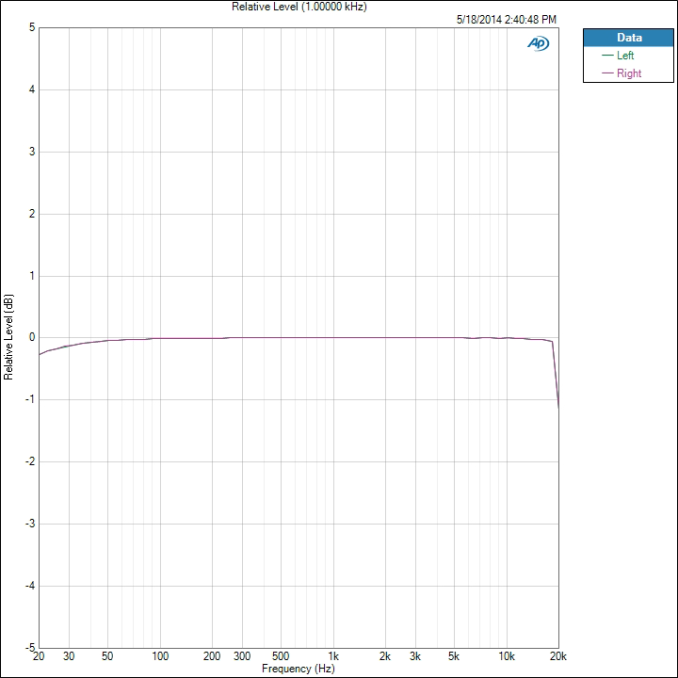
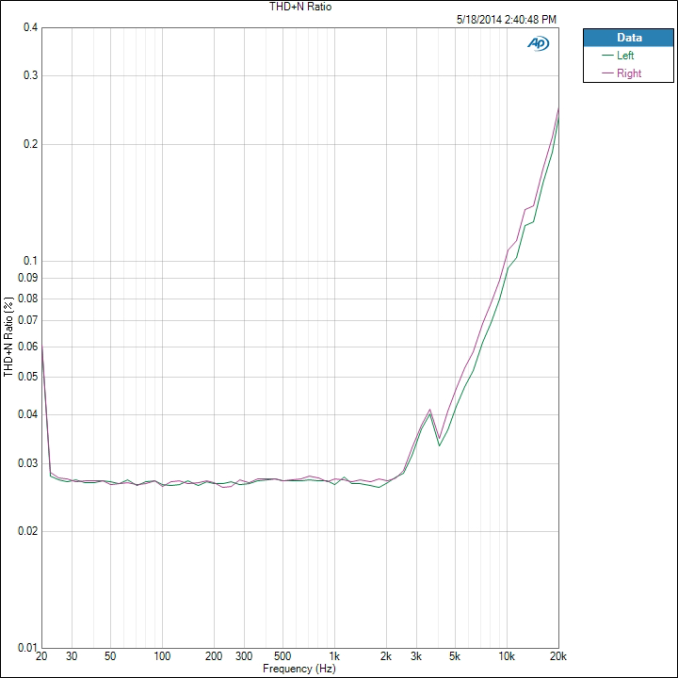
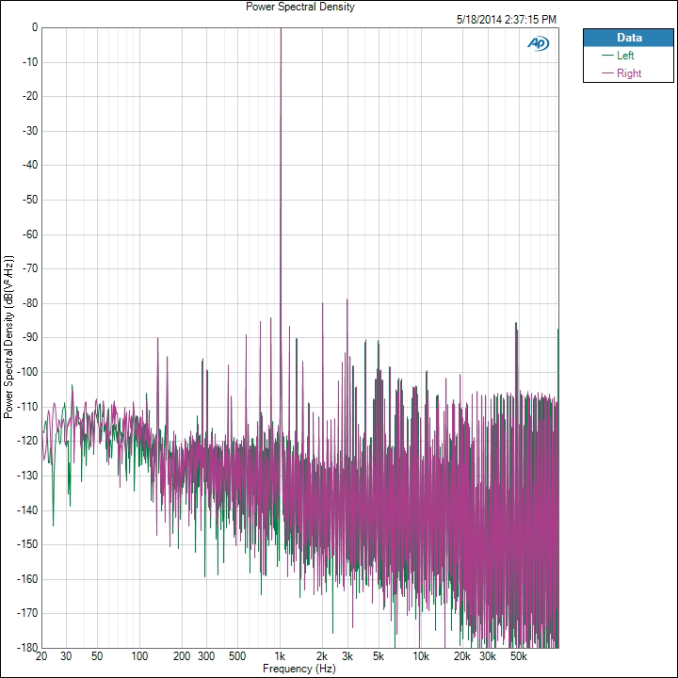
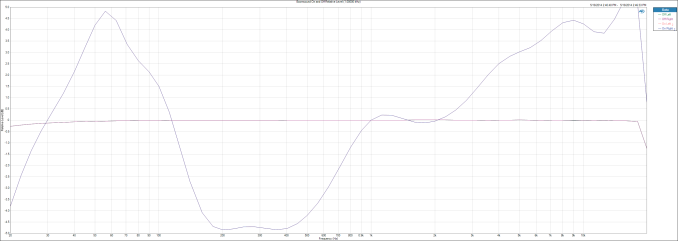
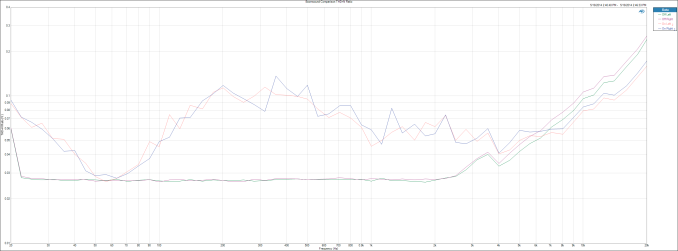








78 Comments
View All Comments
bigboxes - Tuesday, June 3, 2014 - link
I never use the headphone out. I use Bluetooth to connect my Note 3 to my Alpine and the sound is great. The only issue I noticed is an occasional tick in the sound which I assume is when I receive data (texts, e-mails, etc.). Not sure how to eliminate that. If anyone has a suggestion, please let me know.The1Metallian - Tuesday, June 3, 2014 - link
@bigboxes I never have any noise due to notifications. I use a sound profile manager so when I start the music I choose the profile that has notifications muted, media almost all the way up, phone half way up (for emergencies!).I must add that the poor quality is more evident depending on the type of music being played. When the music is mostly guitars, bass, drums and vocals (metal) I don't notice it, but if keyboards come up front then it sounds kinda garbled. The same with sustained cymbals.
You have a Note 3. That device is newer than the GS3. Maybe it has better bluetooth?
bigboxes - Wednesday, June 4, 2014 - link
Probably. However, I came from an HTC 4G EVO LTE. The Bluetooth on that model sucked. I RMA'd a Jawbone headset thinking it was bad. When I got the Note 3 I realized it was just the HTC handset and not the Jawbone. It could be the Bluetooth or it could be the antennas or both. I'm not AnandTech where I have labs and access to different equipment. I can tell you that the audio over Bluetooth sounds amazing. Of course, the Alpine could have something to do with that. :)Jimster480 - Tuesday, June 10, 2014 - link
I had an EVO 4G LTE and I never had any issues with the bluetooth! My father has one too and his bluetooth never acts up. it could have been your phone specifically!cheinonen - Tuesday, June 3, 2014 - link
Bluetooth testing is something I plan to add in the future. I need to decide what I want do with it, but likely something similar to this. There is also a legibility test for talking that can be done over Bluetooth which will be interesting to see. Hopefully Bluetooth doesn't have issues with USB control as analog does, but I will test both ways to be sure.Jimster480 - Tuesday, June 10, 2014 - link
I think that the sound via bluetooth would depend on the DAC of the device on the receiving side? I'm pretty sure bluetooth is a digital signal and therefore the receiving device would have to convert it.haukionkannel - Tuesday, June 3, 2014 - link
Interesting!It would be nice to see some pro portable flack player compared to these phones.
What is the best audio phone and are they even near or a far, far away distance compared to high class portable audio players or real hifi DACs?
cheinonen - Tuesday, June 3, 2014 - link
If you want comparisons to some really high end gear, I've been testing the Auralic Vega DAC ($3,500) and the Auralic Taurus headphone amplifier ($1,900). Since the headphone output here is a combination of a DAC and headphone amp, these numbers aren't exactly comparable.The Vega has 0.000345% THD+N, a frequency deviation of 0.002 dB, Dynamic Range of 125 dB, and Crosstalk of -130 dB.
The Taurus does over 5V into 15 Ohm, and nearly 20V into 33 Ohm, 150 Ohm, and 330 Ohm. It has 0.0004% THD+N, deviation of 0.007dB, 124 dB of Dynamic Range, and -70 dB of Crosstalk. IMD, which isn't measured on the phones, is also below -100 dB at maximum gain.
haukionkannel - Thursday, June 5, 2014 - link
Thanks to this info! But the comparison to real portable devices would be more important. I am in situation where normal phone does not produce good enough sound compared separate mobile music player. I am just wondering if we are getting near the situation where phone is good enough compared to dedicate high-end mobile music player?cheinonen - Thursday, June 5, 2014 - link
I don't really use any portable DACs and amps, either for work or for my daily life. If I get my hands on one I will measure it, but it's an area I don't really venture into.